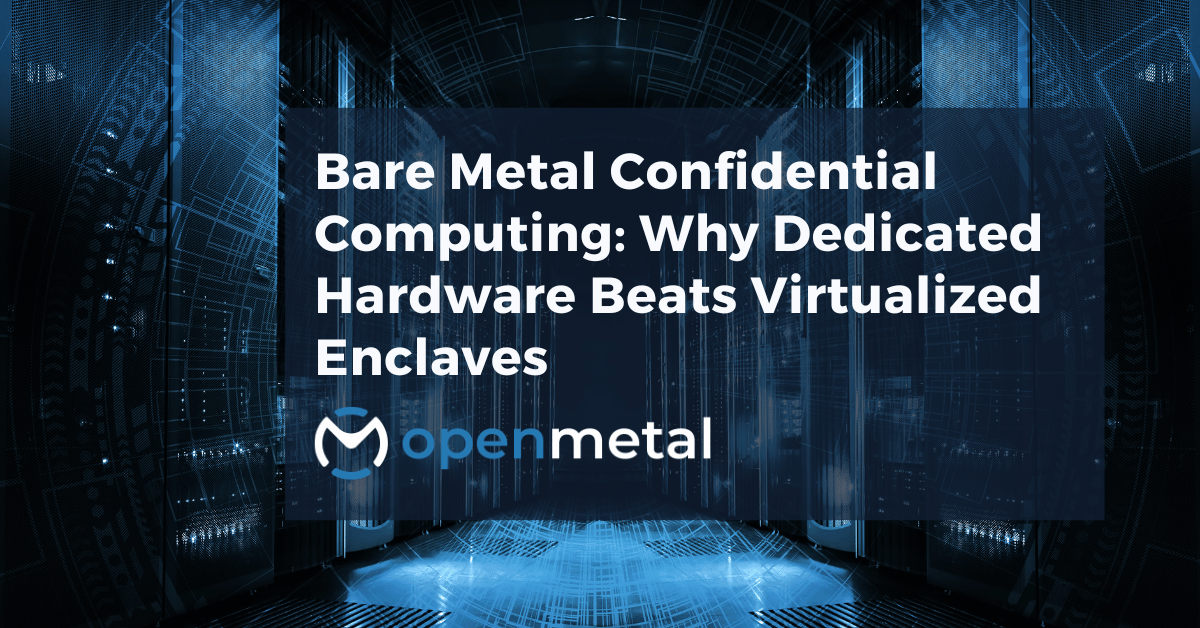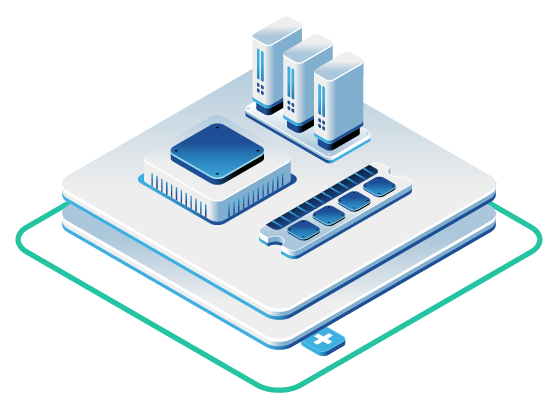
When your organization handles sensitive data—whether financial records, healthcare information, AI models, or blockchain transactions—the question isn’t whether you need confidential computing. It’s whether you can afford to run it on anything less than dedicated bare metal infrastructure.
Confidential Computing protects data in use by performing computation in a hardware-based, attested Trusted Execution Environment1. While this definition sounds straightforward, the implementation makes all the difference. Most organizations today rely on virtualized enclaves running on shared cloud infrastructure, but this approach introduces performance bottlenecks, unpredictable costs, and security trade-offs that can undermine the very protections you’re trying to achieve.
As a bare metal provider, OpenMetal takes a different approach. Confidential computing runs directly on dedicated bare metal servers instead of being layered on top of shared, virtualized environments. This approach gives you the full power of hardware-based trust domains without the overhead and limitations that come with virtualization.
The Hidden Costs of Virtualized Confidential Computing
The appeal of virtualized enclaves is obvious—they promise the security benefits of confidential computing without requiring dedicated hardware. But this convenience comes with significant trade-offs that become apparent once you start running production workloads.
Performance Overhead That Accumulates
Virtualized enclaves introduce performance overhead that compounds across every operation. This overhead isn’t just theoretical—it accumulates with each memory access, context switch, and resource allocation.
Virtualization-based security introduces additional memory and CPU overhead that can degrade performance, especially on systems with high resource demands or latency-sensitive workloads. When you’re processing sensitive AI training data or running real-time financial calculations, these performance penalties directly impact your business outcomes.
The virtualization layer adds latency to every memory access, increases context switching overhead, and introduces unpredictable resource contention. Hypervisors add overhead to every hardware request. For workloads that require consistent, predictable performance—like blockchain validation or high-frequency trading—this overhead can be the difference between meeting SLAs and failing them.
Resource Limitations That Constrain Workloads
The memory available for secure enclave computation directly affects what kinds of workloads can be performed and how efficient the computation will be compared to an unsecured version. While newer processors have expanded these limits, virtualized enclaves still impose constraints that bare metal environments simply don’t have.
Current secure enclave implementations are primarily limited to CPUs, with limited support for specialized hardware like GPUs. This limitation becomes critical when you need to combine confidential computing with GPU acceleration for AI workloads or specialized networking hardware for high-throughput applications.
Unpredictable Costs and Billing Complexity
Public cloud confidential computing typically bills by instance hours, with additional charges for network egress, storage I/O, and often premium pricing for specialized instance types. These costs can spiral quickly, especially for data-intensive workloads that generate significant network traffic or require high-memory configurations.
Memory-intensive applications access their assigned memory throughout their lifetime, meaning significant portions cannot be swapped out safely without negatively impacting performance. When your confidential workloads compete with other tenants for shared resources, you may end up paying for performance you’re not actually getting.
How Bare Metal Changes the Confidential Computing Equation
Bare metal dedicated servers address these limitations head-on by giving you direct access to hardware features without the overhead and constraints of virtualization.
Direct Access to Intel TDX Features
OpenMetal’s v4 hardware lineup includes support for Intel Trust Domain Extensions (TDX), which provides hardware-isolated virtual machines (VM) designed to protect sensitive data and applications from unauthorized access2. Intel TDX uses hardware extensions for managing and encrypting memory and protects both the confidentiality and integrity of the TD CPU state2.
On bare metal, these TDX features work at their full potential because you’re not depending on a hypervisor or sharing physical resources with other tenants. Every processor core, every byte of memory, and every I/O channel is dedicated to your workloads. This means:
- Consistent Performance: No resource contention with other tenants
- Full Hardware Access: Direct use of all TDX features without virtualization overhead
- Predictable Latency: No unexpected delays from hypervisor scheduling
Network Infrastructure Built for Confidential Workloads
Every server in OpenMetal’s platform comes with dual 10 Gbps connections for both public and private networking and unmetered internal traffic. This network architecture is crucial for confidential computing workloads that need to:
- Transfer large encrypted datasets between trust domains
- Synchronize state across multiple confidential instances
- Communicate with external attestation services without bandwidth restrictions
Storage performance matters just as much. OpenMetal builds storage on Micron 7500 NVMe drives, so workloads don’t run into the bottlenecks you often see with cloud storage tiers. When you’re processing sensitive data that must stay encrypted until the moment of computation, storage I/O becomes a critical performance factor.
Flexible Scaling Without Architectural Compromise
You can start small with a Medium V4 for test or lighter production use, or scale up to Large, XL, or XXL V4 servers when you need more memory and throughput for things like AI training or data-heavy applications. The confidential computing features remain consistent across those sizes because the underlying TDX hardware capabilities are the same—you’re just getting more of them.
This scaling model differs fundamentally from cloud instances where moving to larger sizes often means different underlying hardware, different performance characteristics, and different cost structures. With bare metal, you scale by adding more dedicated resources, not by competing for a larger share of shared resources.
Real-World Applications Where Bare Metal Makes the Difference
Financial Services and Real-Time Trading
High-frequency trading systems require microsecond-level latency predictability. In virtualized environments, VMs can affect each other’s performance even when isolated in terms of memory and access. In trading, this kind of performance interference can cost millions.
On dedicated bare metal with TDX, trading algorithms can process confidential market data with consistent latency while maintaining regulatory compliance through hardware attestation. The Intel TDX performance benchmarks on bare metal demonstrate how dedicated hardware eliminates the performance variability that makes virtualized environments unsuitable for latency-sensitive financial applications.
Healthcare Data Processing and HIPAA Compliance
Healthcare organizations need to process patient data while maintaining strict privacy controls. Confidential computing enables privacy-preserving multi-party collaboration, allowing hospital networks to analyze patient outcomes across multiple institutions without exposing individual patient records.
On bare metal, healthcare applications can leverage the full memory capacity of TDX trust domains to process large medical imaging datasets or genomic sequences without the memory limitations imposed by virtualized enclaves. This capability becomes essential when working with high-resolution medical images or complex ML models for diagnostic assistance.
Blockchain Infrastructure and Cryptocurrency Operations
Blockchain validators and cryptocurrency exchanges handle high-value transactions that require both confidentiality and verifiable integrity. Hardware attestation allows verification of enclave identity and ensures only authorized code runs in the secure environment.
The choosing the right infrastructure for privacy-centric blockchain apps guide explains how bare metal infrastructure provides the performance headroom needed for consensus algorithms while maintaining the cryptographic guarantees required for blockchain security.
AI and Machine Learning with Sensitive Data
Training AI models on confidential data requires significant computational resources and memory bandwidth. Virtualized enclaves with limited hardware access make it difficult to perform certain types of workloads, particularly training neural networks that require specialized hardware acceleration.
On bare metal, AI teams can combine TDX-protected compute with GPU clusters for accelerated training while keeping model parameters and training data confidential. This hybrid approach—confidential computing for sensitive data handling paired with specialized hardware for compute acceleration—isn’t feasible in most virtualized environments.
OpenMetal’s Approach to Bare Metal Confidential Computing
Integrated Hardware and Network Stack
OpenMetal makes it possible to combine confidential compute with GPU clusters or Ceph storage clusters when those are part of the picture. This integration happens at the hardware level, not through virtualization layers that add latency and complexity.
All of it is managed through OpenMetal Central or APIs, giving you control over networking, routing, and how workloads are isolated inside your own environment. You can configure trust domains, manage network policies, and monitor performance through a single interface designed specifically for bare metal infrastructure.
Predictable Economics
Because OpenMetal prices by server rather than by usage or per-VM licensing, you know exactly what you’re paying for the full machine. That model often ends up more predictable and more efficient than public cloud confidential computing, where billing is tied to each instance plus network egress.
On bare metal, the full hardware capacity is available to you, and how you divide it across workloads is up to you. This means you can run multiple confidential workloads on the same server, share resources between development and production environments, or dedicate entire machines to single high-priority applications—all without additional licensing fees or usage-based charges.
Security Through Hardware Control
For teams that need to run sensitive workloads—whether in finance, healthcare, blockchain, or AI—confidential computing on bare metal gives them both the security features of Intel TDX and the consistency that comes from running on infrastructure they fully control.
With secure enclaves on dedicated hardware, organizations can implement security measures that block malicious actions while allowing legitimate operations to proceed transparently. On bare metal, this protection extends to the physical infrastructure level, where you control the entire stack from hardware through operating system.
Making the Strategic Choice
The decision between virtualized enclaves and bare metal confidential computing ultimately comes down to what you can’t afford to compromise on. If cost minimization and operational simplicity are your primary concerns, virtualized enclaves might suffice for development workloads or applications with loose performance requirements.
But if you’re processing data where performance inconsistency translates to business risk, where regulatory compliance requires verifiable security controls, or where the computational requirements exceed what virtualized environments can efficiently deliver, bare metal becomes not just an option but a necessity.
The confidential computing infrastructure future-proofing AI, blockchain, and SaaS products article details how organizations are using dedicated hardware to build applications that simply wouldn’t be feasible on shared infrastructure.
Confidential computing protects data in use, including cryptographic keys. When those keys control access to millions of dollars in digital assets, patient health records, or proprietary AI models, the infrastructure hosting them needs to be as reliable and performant as the security guarantees they provide.
Bare metal confidential computing isn’t just about better performance or lower costs—it’s about having the infrastructure foundation that your most critical applications deserve.
[1] Confidential Computing Consortium. https://confidentialcomputing.io/
[2] Intel. “Intel® Trust Domain Extensions (Intel® TDX).” https://www.intel.com/content/www/us/en/developer/tools/trust-domain-extensions/overview.html
Read More on the OpenMetal Blog


































